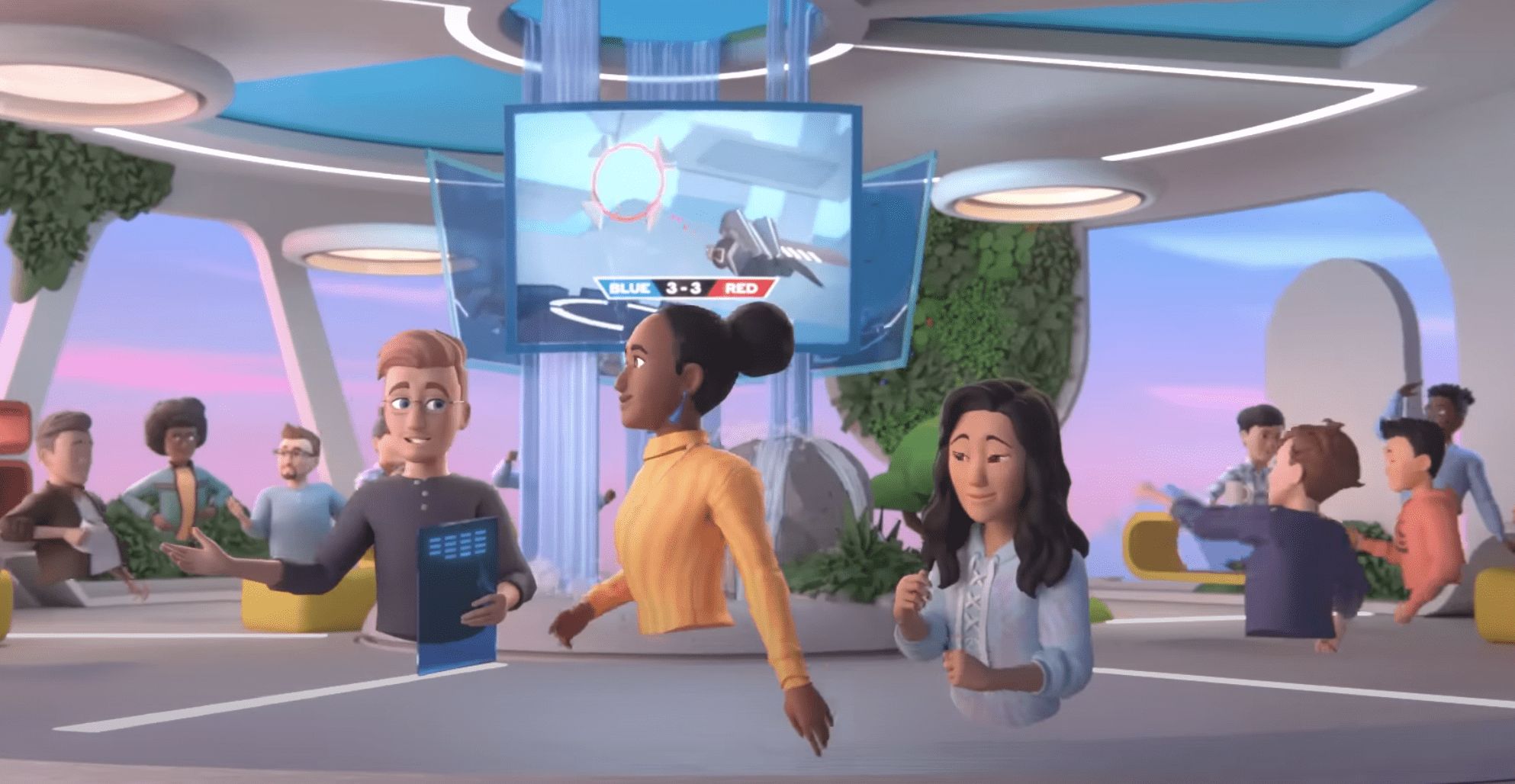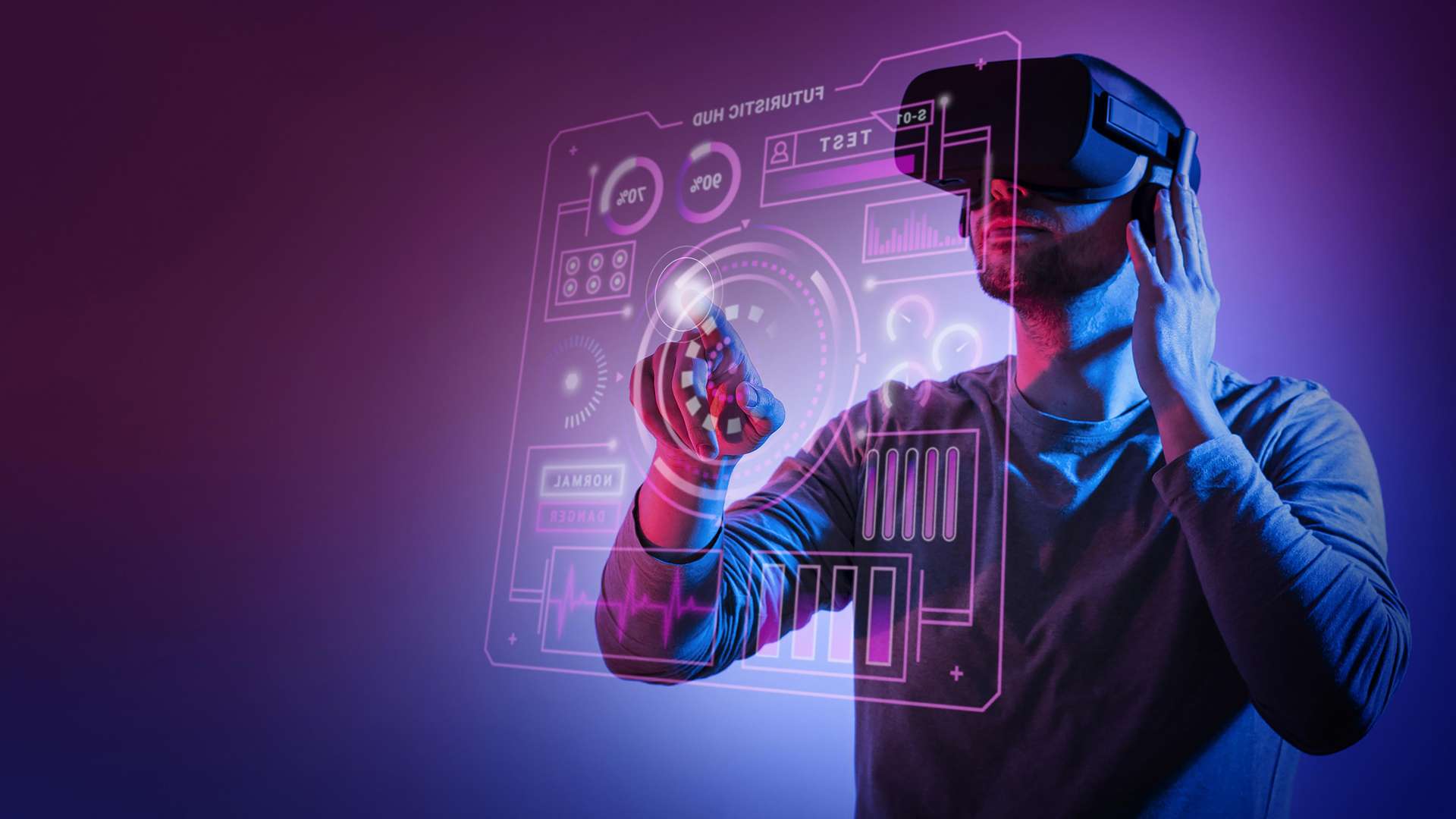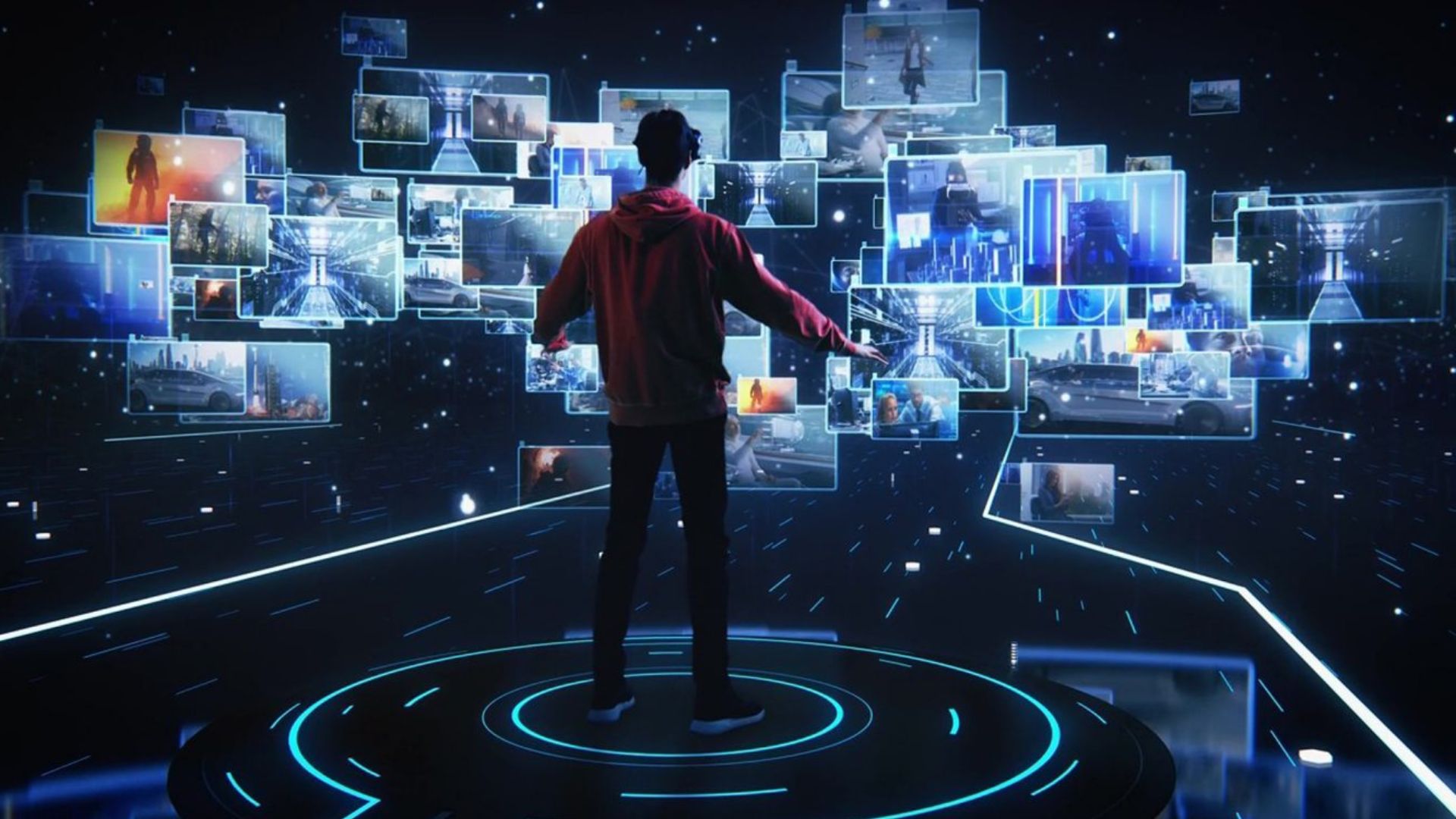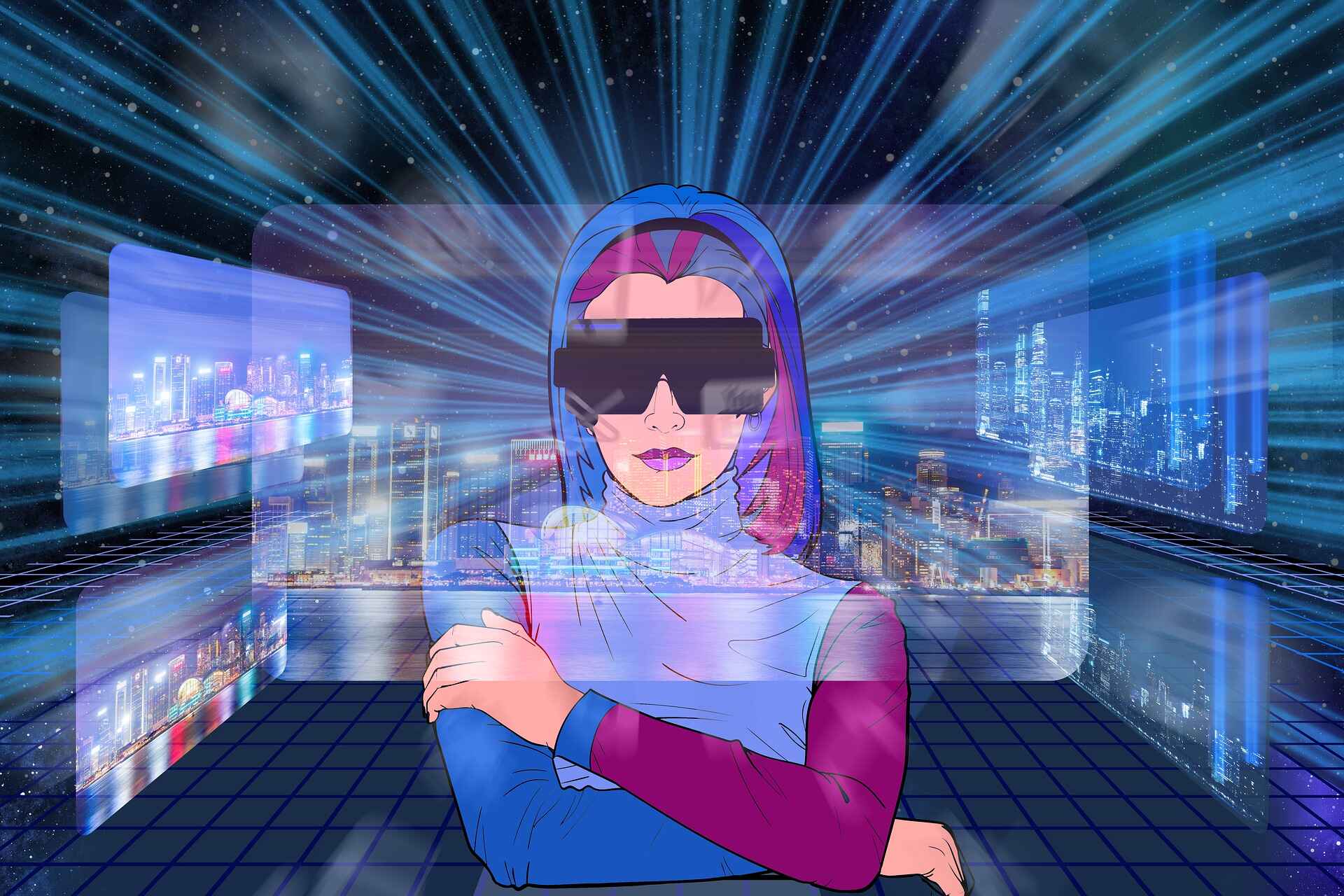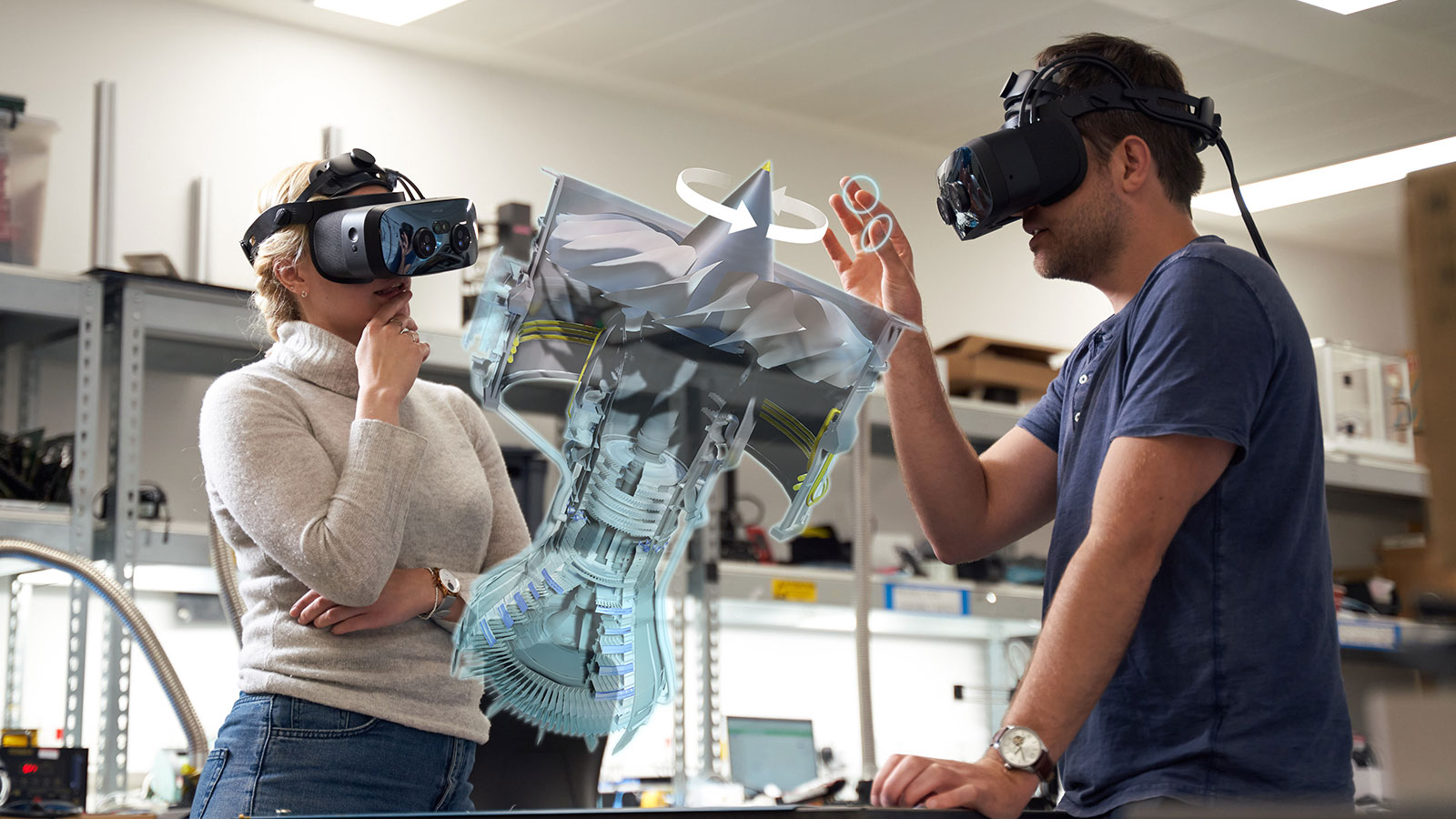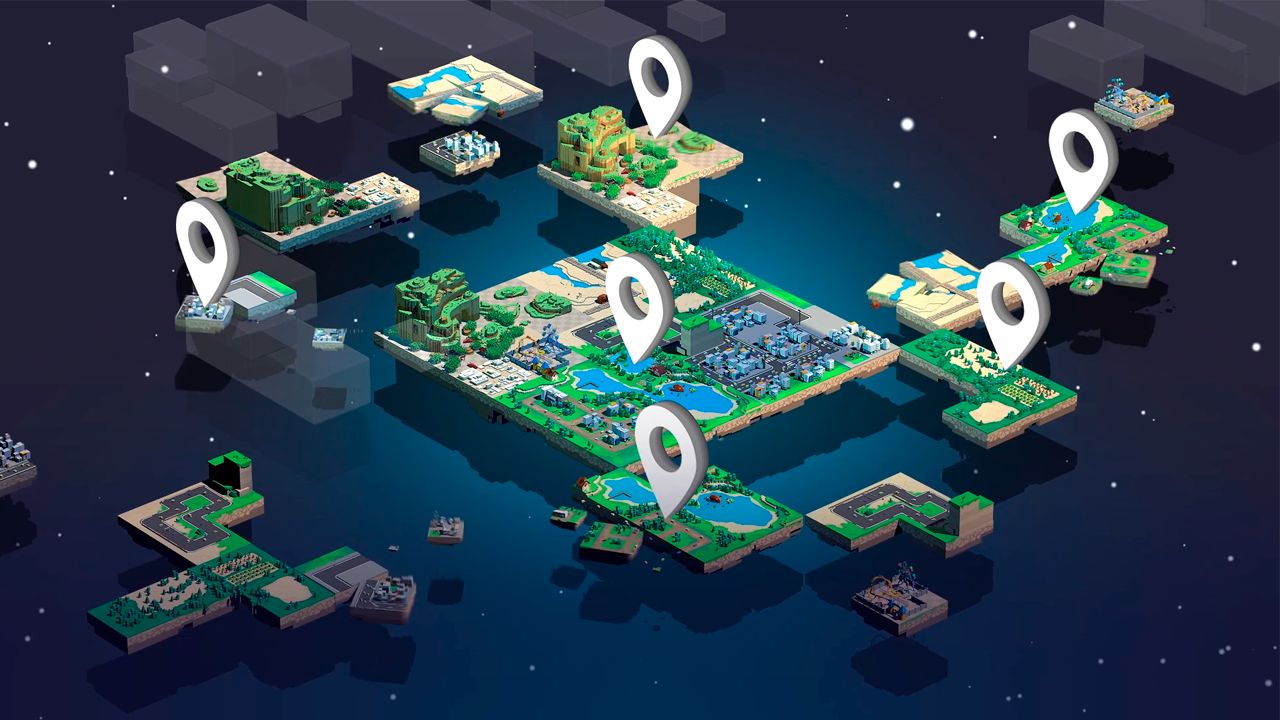Introduction
The concept of the metaverse has captivated our imagination for decades, and now it is on the brink of becoming a reality. Growing at a rapid pace, the metaverse promises to change the way we live, work, and interact in the digital realm. With advancements in technology, such as virtual reality (VR) and enhanced internet connectivity, the metaverse is set to reshape our digital experiences.
The metaverse refers to a collective virtual shared space, created by the convergence of the physical and virtual worlds. It is a fully immersive and interactive environment, allowing users to engage with digital content and interact with others in unprecedented ways. In the metaverse, you can explore virtual landscapes, socialize with friends from different corners of the world, participate in virtual events, attend virtual classes, and even conduct business meetings, all within a virtual framework.
Technological advancements have played a crucial role in fueling the rise of the metaverse. The development of VR technology has revolutionized how we perceive and experience the digital world. With headsets and controllers, users can enter virtual environments that feel realistic and immersive, enabling them to interact with digital objects and other users as if they were in the same physical space. This level of immersion and interactivity has propelled the popularity of VR and created a strong foundation for the metaverse to thrive.
Furthermore, advancements in connectivity and internet speeds have laid the groundwork for seamless interactions within the metaverse. Improved broadband connections, 5G networks, and the upcoming deployment of satellite-based internet systems promise to deliver faster and more reliable internet access globally. This enhanced connectivity will enable users from even the most remote regions to access the metaverse, fostering a truly inclusive digital ecosystem.
The metaverse offers a multitude of benefits that make it an exciting prospect for individuals, businesses, and society as a whole. This virtual realm opens up unlimited possibilities and virtual realities, providing an escape from the constraints of the physical world. In the metaverse, people can explore new places, pursue their passions, and indulge in imaginative experiences that were previously unimaginable. The metaverse transcends geographical boundaries, providing a platform for people to connect, collaborate, and create together, regardless of their physical locations.
Stay tuned for the next section, where we will delve deeper into the technological advancements that have paved the way for the metaverse to succeed.
The Concept of the Metaverse
The metaverse is a groundbreaking concept that brings together elements from science fiction and virtual reality to create a fully immersive and interconnected digital world. Coined by the science fiction writer Neal Stephenson in his novel “Snow Crash,” the term refers to a collective virtual shared space where users can interact with each other and digital content in a seamless and immersive manner. Unlike the internet we know today, the metaverse aims to create a more immersive and interactive experience by integrating real-time social interactions, virtual reality, and artificial intelligence.
The metaverse is not just a singular virtual reality platform; rather, it encompasses a multitude of interconnected virtual worlds and experiences that are accessible through a variety of devices and applications. It allows users to enter these digital realms and engage with virtual objects and environments, as well as connect with other users in real-time. Imagine being able to attend a concert, explore a virtual museum, or have a business meeting with colleagues from different parts of the world, all within the metaverse.
One crucial aspect of the metaverse is its ability to blur the lines between the physical and digital worlds. Through the use of haptic feedback, motion recognition, and realistic graphics, the metaverse aims to create an immersive experience that simulates real-world sensations. It aims to provide a sense of presence and embodiment, making users feel as if they are truly present in the virtual environment. This level of immersion is what sets the metaverse apart from traditional online experiences.
Another key element of the metaverse is its emphasis on social interactions. In the metaverse, users can interact with each other through avatars, which are virtual representations of themselves. These avatars can communicate and collaborate with other users, enabling social interactions that mimic real-life interactions. This social aspect of the metaverse fosters a sense of community and connection, allowing users to build relationships and engage in shared experiences in a virtual space.
Moreover, the metaverse opens up a plethora of opportunities for content creators, developers, and businesses. It provides a platform for artists, designers, and creators to showcase their virtual creations and monetize their skills. Businesses can leverage the metaverse to create virtual storefronts, host virtual events, and tap into a global audience. With the metaverse, creativity and entrepreneurship can thrive in a digital landscape that knows no geographical boundaries.
As the metaverse continues to evolve, it is important to navigate the ethical and legal challenges that arise. Issues such as intellectual property rights, privacy, and accessibility need to be addressed to ensure a fair and inclusive metaverse for all users. With proper regulations and guidelines in place, the metaverse can become a transformative force that enhances our digital experiences and expands the boundaries of human interaction.
Next, we will explore the technological advancements that have propelled the rise of the metaverse.
Technological Advancements
Technological advancements have played a pivotal role in bringing the concept of the metaverse to life. Significant improvements in virtual reality (VR) technology, enhanced internet connectivity, and the development of artificial intelligence (AI) have paved the way for the metaverse to flourish.
One of the key advancements driving the metaverse is the evolution of VR technology. VR headsets and controllers have become more accessible and affordable, enabling users to immerse themselves in virtual environments. These devices offer high-resolution displays, accurate motion tracking, and intuitive user interfaces, delivering a more realistic and captivating experience. With the ability to interact with digital objects and navigate virtual spaces, users can fully engage with the metaverse and explore its vast potential.
Furthermore, improvements in internet connectivity have been vital for the growth of the metaverse. The advent of 5G networks and the increasing availability of high-speed internet have greatly enhanced the bandwidth and latency required for seamless virtual experiences. This level of connectivity ensures that users can participate in real-time interactions, whether it’s attending virtual events, collaborating with others, or exploring virtual worlds. Additionally, the deployment of satellite-based internet systems, such as SpaceX’s Starlink, aims to provide global internet coverage, further extending the reach of the metaverse to even the most remote areas.
The development of AI has also played a significant role in augmenting the metaverse experience. AI-powered algorithms can generate realistic and diverse virtual environments, populate them with intelligent NPCs (non-player characters), and facilitate dynamic interactions within the metaverse. AI can enhance user experiences by providing personalization, context-awareness, and intelligent assistance. It assists in creating immersive narratives, adaptive gameplay, and responsive virtual environments that adapt to the actions and preferences of the users.
Additionally, the convergence of virtual reality (VR) and augmented reality (AR) technologies has expanded the possibilities of the metaverse. AR blends virtual objects with the real world, overlaying digital information onto the physical environment. This integration allows users to seamlessly transition between virtual and physical spaces, adding another layer of immersion and interaction to the metaverse. It opens up new opportunities for applications in areas such as education, training, design, and entertainment.
As technology continues to advance, we can expect further improvements in the metaverse experience. The development of more powerful and compact VR devices, advancements in AI and machine learning, and the continued growth of internet infrastructure will enhance the possibilities and capabilities of the metaverse. These technological advancements will contribute to a more seamless, immersive, and interconnected metaverse, revolutionizing the way we engage and interact within the digital realm.
In the next section, we will explore the rising popularity of virtual reality and its impact on the metaverse.
Rising Popularity of Virtual Reality (VR)
Virtual reality (VR) has gained significant traction in recent years, paving the way for the rise of the metaverse. With its ability to create immersive and interactive digital experiences, VR technology has captured the attention of both consumers and businesses, driving the growth of the metaverse.
One of the main factors contributing to the popularity of VR is its ability to transport users to virtual environments and provide a sense of presence. VR headsets, equipped with high-resolution displays and motion tracking sensors, create a convincing illusion of being present in a different world. This level of immersion allows users to feel as if they are part of the virtual environment, whether it’s exploring a distant planet, diving into the depths of the ocean, or walking through a virtual museum.
The entertainment industry has played a crucial role in popularizing VR. Video game developers have harnesses VR technology to create highly immersive and captivating gaming experiences. Players can step into the shoes of their favorite characters, interact with the virtual world, and engage in thrilling gameplay. The gaming industry’s embrace of VR has contributed to a growing user base and an increasing demand for more immersive and interactive virtual experiences.
Aside from gaming, VR is impacting various other industries. In the field of architecture and design, VR enables architects and designers to visualize and explore virtual prototypes of buildings and spaces, making it easier to iterate and refine designs before construction. VR is also being leveraged in training and education, providing realistic simulations and virtual classrooms for enhanced learning experiences. Healthcare professionals are utilizing VR to train and practice complex medical procedures, improving patient care and safety. Furthermore, VR is being utilized for virtual tourism, allowing people to virtually visit famous landmarks, museums, and tourist destinations from the comfort of their homes.
As VR technology becomes more accessible and affordable, its adoption is expected to continue growing. Major tech companies, such as Facebook (with Oculus), Sony (with PlayStation VR), and HTC (with Vive), are investing heavily in VR, driving innovation and pushing the boundaries of what is possible in virtual reality. The development of standalone VR headsets, which do not require a tethered connection to a PC or console, has further contributed to the accessibility of VR experiences.
The rising popularity of VR has created a strong foundation for the metaverse to thrive. VR technology provides the essential tools and platforms for users to access and interact with the metaverse’s virtual worlds. Its immersive capabilities, combined with advancements in connectivity and AI, enable users to engage with others and digital content in a seamless and realistic manner.
In the next section, we will discuss how enhanced connectivity and internet speeds are crucial for the success of the metaverse.
Enhanced Connectivity and Internet Speeds
Enhanced connectivity and faster internet speeds are essential for the success of the metaverse. As the metaverse aims to create a seamless and immersive digital environment, robust internet infrastructure is crucial to ensure smooth interactions and real-time experiences for users.
One of the key factors driving the growth of the metaverse is the advancement of broadband internet connections. High-speed internet access enables users to easily connect to the metaverse and engage with virtual content and other users. Traditional broadband connections, such as fiber-optic and cable connections, provide the necessary bandwidth for streaming high-quality virtual reality (VR) content and participating in real-time interactions within the metaverse. The availability of broadband in both urban and rural areas is pivotal to ensure equal access to the metaverse for all users, regardless of their geographical location.
The deployment of 5G networks is set to revolutionize connectivity and further expand the possibilities of the metaverse. 5G networks offer ultra-low latency and faster download and upload speeds, which are essential for real-time interactions within the metaverse. With 5G, users can engage in bandwidth-intensive activities, such as streaming high-resolution VR content, participating in multiplayer experiences, and collaborating with others. 5G’s low latency also ensures minimal lag and a more immersive experience, as interactions in the metaverse will feel instantaneous and responsive. The widespread adoption of 5G networks will enhance the accessibility and capabilities of the metaverse, enabling a wide range of industries and applications to flourish within this virtual realm.
In addition to terrestrial networks, satellite-based internet systems are also being developed to provide global internet coverage, extending the reach of the metaverse to even the most remote areas. Companies like SpaceX with their Starlink project aim to launch a constellation of satellites that will provide high-speed broadband connectivity to underserved regions. By bridging the digital divide, satellite-based internet systems contribute to a more inclusive metaverse, ensuring that users around the world can access and participate in the digital ecosystem.
Enhanced connectivity not only enables individuals to access the metaverse but also supports seamless collaboration and communication among users. The metaverse is designed to foster social interactions, virtual events, and collaborative workspaces. Reliable and fast internet connections allow users to engage in real-time conversations, share virtual experiences, and collaborate on projects within the metaverse. With improved connectivity, professionals can participate in virtual meetings, students can attend virtual classes, and artists can collaborate on digital creations, all without the limitations imposed by physical space and distance.
As the metaverse continues to evolve, the demand for enhanced connectivity and faster internet speeds is expected to grow. The development and implementation of advanced internet technologies, including 5G networks and satellite internet systems, will be crucial to meet the needs of the metaverse and support its ever-expanding user base. By ensuring widespread and reliable connectivity, we can unlock the full potential of the metaverse and usher in a new era of immersive digital interactions.
In the next section, we will explore the numerous benefits and possibilities that the metaverse offers.
Benefits of the Metaverse
The metaverse offers a multitude of benefits that make it an exciting and transformative concept. As this digital realm continues to develop, individuals, businesses, and society as a whole can reap the following advantages:
Unlimited Possibilities and Virtual Realities: The metaverse transcends the constraints of the physical world, providing an expansive and imaginative digital landscape. Within the metaverse, users can explore limitless virtual realities, ranging from fantastical realms to realistic simulations. This opens up a world of possibilities for creative expression, personal exploration, and immersive experiences.
Economic Growth and Job Opportunities: The metaverse has the potential to drive economic growth by opening up new avenues for innovation and entrepreneurship. The development of virtual products, services, and experiences can create jobs and stimulate economic activity. Content creators, developers, designers, and entrepreneurs can thrive in this digital ecosystem, capitalizing on the metaverse’s global reach and collaborative nature.
Improved Education and Collaboration: The metaverse has the power to revolutionize education by providing immersive learning experiences. Students can engage in virtual classrooms, where they can interact with teachers, peers, and educational content in a dynamic and interactive manner. Collaborative projects and simulations can enhance understanding and retention of complex concepts. The metaverse also enables professionals from various fields to collaborate in virtual workspaces, transcending geographical boundaries and fostering global teamwork.
Social Interactions and Community Building: In the metaverse, individuals can connect with others from around the world, enabling social interactions and community building. Virtual gatherings, events, and social spaces provide opportunities for like-minded individuals to come together, form friendships, and share experiences. The metaverse promotes inclusivity and diversity, creating a sense of belonging and fostering a sense of community that transcends physical limitations.
Artistic Expression and Cultural Preservation: The metaverse offers a platform for artists, musicians, and creators to showcase their work, reach a global audience, and monetize their talents. Whether it’s virtual art galleries, live music performances, or immersive storytelling, the metaverse provides new avenues for artistic expression and cultural preservation. It enables the exploration and celebration of diverse cultural experiences and traditions, fostering cross-cultural understanding and appreciation.
Healthcare Advancements and Therapy: The metaverse holds potential in the field of healthcare, offering opportunities for medical research, training, and therapy. Virtual simulations can aid in surgical training and medical education. Virtual reality therapy can be provided for mental health conditions, such as phobias and post-traumatic stress disorder (PTSD). By leveraging the metaverse, healthcare professionals can enhance patient care, accessibility, and outcomes.
These are just a few examples of the benefits that the metaverse brings. As technology and connectivity continue to advance, the metaverse holds tremendous potential to shape the future of how we live, work, learn, and interact within the digital realm.
Unlimited Possibilities and Virtual Realities
One of the key attractions of the metaverse is the vast array of unlimited possibilities and virtual realities it offers. Unlike the physical world, which has certain limitations, the metaverse allows individuals to explore and engage with an expansive and imaginative digital landscape.
Within the metaverse, users can immerse themselves in diverse virtual realities that cater to a wide range of interests and preferences. From fantastical realms and futuristic cities to historically accurate simulations and virtual replicas of real-world locations, the metaverse provides a platform for limitless creativity and exploration. Users can explore uncharted territories, engage in epic adventures, or simply unwind in tranquil virtual environments. The metaverse enables individuals to escape the boundaries of the physical world and venture into new and captivating digital realms.
Virtual reality (VR) is at the core of the metaverse, enabling users to experience these virtual realities in an immersive and interactive way. Through VR headsets and controllers, users can see and interact with virtual objects and environments, making the experience feel incredibly realistic. Whether it’s climbing virtual mountains, diving into the depths of the ocean, or flying through space, the metaverse allows users to engage their senses and embark on incredible virtual adventures.
Moreover, the metaverse is not confined to a single virtual reality. It encompasses a multitude of interconnected virtual worlds and experiences, each with its own unique characteristics and offerings. This means that users can seamlessly transition between different virtual realities, exploring various landscapes and engaging with different communities and content. The metaverse accommodates a wide range of preferences and interests, catering to diverse individuals and allowing them to shape their digital experiences to suit their needs.
The metaverse also presents opportunities for users to create their own virtual realities and contribute to the ever-expanding digital landscape. Content creators, artists, and designers can unleash their creativity and bring their visions to life within the metaverse. They can design and build virtual environments, create interactive experiences, and craft virtual objects and avatars. This freedom to create and share within the metaverse fosters a vibrant and dynamic community, where individuals can collaborate, inspire, and engage with one another.
Virtual reality and the unlimited possibilities of the metaverse extend beyond entertainment and leisure. The metaverse has applications in various industries and fields, including education, training, design, healthcare, and more. For example, students can explore virtual simulations and interactive educational content, enhancing their learning experiences. Architects and designers can visualize and iterate on virtual prototypes before construction begins, saving time and resources. Healthcare professionals can use virtual reality for medical training and therapy, providing more effective and accessible healthcare solutions.
As the metaverse continues to evolve, the range of possibilities and virtual realities will expand even further. Technological advancements, coupled with the creativity and innovation of content creators and users, will continue to push the boundaries of what is possible within the metaverse. The unlimited possibilities and virtual realities of the metaverse offer individuals the chance to explore, create, and shape their digital experiences in ways that were previously unimaginable.
Economic Growth and Job Opportunities
The metaverse not only presents a new digital frontier but also brings with it immense economic growth and job opportunities. As this virtual realm continues to evolve, it creates a thriving ecosystem that fosters innovation, entrepreneurship, and economic prosperity.
One of the main drivers of economic growth in the metaverse is the creation and monetization of virtual products, services, and experiences. Content creators, developers, and designers have the opportunity to showcase their talents and skills within the metaverse. They can design and sell virtual clothing, accessories, and other digital assets, catering to the growing demand for personalization and self-expression. Virtual marketplaces provide a platform for buying and selling these virtual goods, allowing creators to generate revenue and make a living from their creations.
The metaverse also offers a plethora of opportunities for entrepreneurs to launch virtual businesses and services. Virtual storefronts can be established to sell digital and physical products, catering to the global metaverse audience. Businesses can host virtual events such as conferences, concerts, and exhibitions, attracting participants from all over the world. Advertisers can explore innovative methods to reach target audiences within the metaverse, creating new revenue streams and advertising models.
Furthermore, the metaverse acts as a catalyst for job creation. As the metaverse expands, the demand for skilled professionals in various fields will rise. Content creators, 3D artists, developers, animators, virtual architects, and designers are just a few examples of the roles that will be in demand within the metaverse ecosystem. These professionals will be responsible for creating captivating virtual experiences, designing virtual environments, and ensuring the smooth functioning of the digital infrastructure.
Moreover, the metaverse fosters collaborative ventures and partnerships, further driving economic growth. Enterprises can collaborate with content creators, designers, and developers to create immersive brand experiences within the metaverse. Businesses can leverage the metaverse’s global reach and engage with a broader audience, expanding market opportunities and revenue potential.
The metaverse also presents opportunities for traditional industries to transform and adapt to the digital landscape. For instance, educational institutions can embrace virtual classrooms and use the metaverse as a platform for remote learning and collaboration. Real estate professionals can leverage the metaverse to showcase virtual property tours and pre-visualize architectural designs. The entertainment industry can create interactive experiences and live performances that engage audiences within the metaverse.
As the metaverse continues to grow, it will generate not only direct job opportunities but also support industries that provide ancillary services. Legal, financial, marketing, and support services will be needed to navigate the legal, financial, and operational intricacies of the metaverse ecosystem.
The economic growth and job opportunities arising from the metaverse will have a ripple effect on society as a whole. It will drive technological advancements, inspire innovation, and contribute to the overall economic well-being by creating new markets and revenue streams. The metaverse has the potential to shape the future of work, allowing individuals to pursue careers in new and exciting digital realms, and providing economic opportunities that transcend physical borders.
Improved Education and Collaboration
The metaverse holds tremendous potential to revolutionize education and foster collaborative environments that transcend physical limitations. This digital realm offers a range of possibilities for enhanced learning experiences, immersive training, and global collaborations.
One of the key advantages of the metaverse in education is the ability to create immersive and interactive learning environments. Students can enter virtual classrooms, where they can engage with teachers and peers in real-time, regardless of their geographical locations. Virtual classrooms provide opportunities for interactive discussions, virtual experiments, and simulations that allow students to grasp complex concepts through hands-on experiences. The metaverse enables educators to deliver personalized learning experiences tailored to the needs of individual students, catering to various learning styles and preferences.
Beyond traditional academic settings, the metaverse offers practical applications for vocational training and professional development. Virtual reality simulations can provide hands-on training opportunities for a range of professions, including healthcare, engineering, and aviation. These simulations offer realistic scenarios and allow learners to practice their skills in a risk-free and controlled environment. The metaverse can facilitate industry collaborations, enabling professionals from different parts of the world to work together on projects and research, fostering knowledge exchange and innovation.
Collaboration is a fundamental aspect of the metaverse, enabling individuals to engage in real-time teamwork and problem-solving activities. Virtual workspaces within the metaverse allow geographically dispersed teams to come together, collaborate on projects, and share ideas seamlessly. The metaverse facilitates effective communication through voice and video conferencing, instant messaging, and shared virtual whiteboards. These collaborative tools bridge distances, encourage creativity, and support the collective efforts of individuals from diverse backgrounds.
Moreover, the metaverse promotes cross-cultural understanding and global collaboration. Students and professionals from different parts of the world can connect, exchange ideas, and collaborate on a shared platform. This multicultural and inclusive environment fosters a deeper appreciation and understanding of diverse perspectives, nurturing a global mindset and strengthening intercultural competence.
Additionally, the metaverse offers opportunities for lifelong learning and continuous skill development. Individuals can access a wide range of educational resources, such as virtual libraries, online courses, and interactive educational content. The metaverse facilitates self-paced learning, allowing individuals to expand their knowledge and acquire new skills at their own convenience. Lifelong learners can pursue their interests, engage in self-directed learning, and connect with communities of like-minded learners within the metaverse.
By harnessing the potential of the metaverse in education and collaboration, we can break down barriers of access and create a more inclusive and equitable learning environment. The metaverse has the power to transcend physical constraints, democratize education, enhance collaboration, and nurture a lifelong learning mindset that is vital for the ever-evolving digital age.
Social Interactions and Community Building
The metaverse revolutionizes social interactions by providing a platform for individuals to connect, engage, and build communities in a virtual environment. It fosters a sense of belonging, encourages collaboration, and transcends the boundaries of physical distance.
One of the primary attractions of the metaverse is the ability to forge connections and socialize with others from around the world. Within the metaverse, individuals can interact with each other through avatars, which are virtual representations of themselves. Avatars enable users to express their unique identities and engage in real-time conversations and activities, simulating face-to-face interactions. This social aspect of the metaverse creates opportunities for individuals to meet new people, build friendships, and expand their social networks beyond geographic limitations.
The metaverse provides a wide range of social spaces where like-minded individuals can gather and engage in shared experiences. Virtual lounges, clubs, and gathering spots serve as hubs for social interactions and allow individuals to connect based on their interests, hobbies, and passions. Whether it’s attending virtual parties, joining interest-based communities, or participating in virtual group activities, the metaverse fosters a sense of connection and camaraderie.
Community building is another crucial element of the metaverse. Individuals can join and create virtual communities centered around specific themes, causes, or shared goals. These communities provide a digital space where individuals with common interests can come together, exchange ideas, and collaborate. Whether it’s a community focused on art, entrepreneurship, gaming, or social activism, the metaverse enables individuals to find and connect with like-minded individuals, fostering a sense of belonging and support.
The metaverse also allows for the organization and hosting of virtual events, such as conferences, exhibitions, and concerts. These events bring people together, offering opportunities to network, learn, and engage with speakers, performers, and attendees. The metaverse amplifies the reach and impact of such events, as individuals from different parts of the world can participate without the constraints of travel or physical venue limitations.
Virtual experiences within the metaverse enable social interactions in a way that complements and extends real-life interactions. Users can collaborate on projects, play games together, attend virtual classes or workshops, and engage in shared virtual adventures. The metaverse creates a dynamic and interactive environment that simulates real-world social dynamics, allowing individuals to bond and build relationships based on shared experiences.
Furthermore, the metaverse promotes inclusivity and diversity. In virtual spaces, individuals have the freedom to express themselves without the biases and limitations often associated with physical appearance or societal expectations. This inclusion allows for the celebration and exploration of diverse cultures, identities, and experiences. The metaverse acts as a catalyst for connecting people from varied backgrounds, fostering cross-cultural understanding and nurturing a sense of empathy and global citizenship.
As the metaverse continues to evolve, social interactions and community-building within this digital realm will become increasingly sophisticated. The metaverse offers a boundless space for individuals to connect, collaborate, and build meaningful relationships, enhancing social experiences and creating a sense of belonging that transcends physical barriers.
Challenges and Concerns
While the metaverse holds tremendous potential, it is important to address the challenges and concerns that arise with this groundbreaking concept. As the metaverse continues to evolve, several key issues need to be navigated to ensure its positive impact and sustainable development.
Privacy and Security: With the metaverse relying heavily on user-generated content and personal data, privacy and security concerns become paramount. Safeguarding user information, protecting against cyber threats, and ensuring user consent for data usage are essential considerations. There is a need for robust regulations and technological measures to preserve the privacy and security of individuals within the metaverse.
Inclusivity and Accessibility: The metaverse should strive to be accessible to all individuals, regardless of their socioeconomic status, physical abilities, or technological resources. Ensuring inclusivity requires addressing infrastructure disparities, affordability concerns, and designing user interfaces that accommodate different needs and abilities. Access to the metaverse should not be limited to a privileged few, but rather made available to individuals from diverse backgrounds.
Ethical and Legal Issues: As the metaverse evolves, ethical and legal frameworks must be established to govern behavior and ensure accountability. Issues such as intellectual property rights, content moderation, digital identity, and user rights need to be addressed to create a fair and equitable metaverse. Implementing guidelines and regulations that promote responsible and ethical behavior is essential to protect users and maintain ethical standards within this digital realm.
Virtual Addiction and Health Concerns: The immersive nature of the metaverse raises concerns about potential addictive behaviors and the impact on mental health. Spending extensive amounts of time in virtual environments may lead to social isolation, disconnection from reality, and psychological disturbances. Educating users about responsible usage, implementing breaks, and providing mental health support resources are areas that need to be focused on to mitigate these potential risks.
Digital Divide and Technological Barriers: Bridging the digital divide and addressing technological barriers are vital to ensure equal access to the metaverse. Disparities in internet connectivity, lack of affordable devices, and limited digital literacy can create challenges in adopting and benefiting from the metaverse, particularly in marginalized communities. Governments and organizations need to invest in infrastructure development, provide affordable technology access, and promote digital literacy initiatives to bridge these gaps.
Content Quality and Misinformation: With the metaverse being a user-generated content platform, ensuring the quality, accuracy, and accountability of information becomes crucial. The spread of misinformation, hate speech, and harmful content within the metaverse can damage the user experience and lead to real-world consequences. Implementing content moderation mechanisms, user reporting systems, and promoting digital media literacy are essential to maintain the integrity and safety of the metaverse.
Addressing these challenges and concerns requires collaboration among various stakeholders, including technology companies, policymakers, educators, and users. By proactively addressing these issues, the potential of the metaverse can be harnessed while minimizing negative impacts, ensuring a safe, inclusive, and sustainable digital ecosystem for all.
Privacy and Security
Privacy and security are paramount concerns in the evolving landscape of the metaverse. As this digital realm expands, it becomes crucial to address these issues to protect the rights and well-being of users within the metaverse.
With the metaverse heavily reliant on user-generated content and personal data, safeguarding user information is of utmost importance. Users should have control over their data and be able to make informed decisions about its usage. Implementing transparent data collection practices, robust encryption methods, and data minimization techniques are essential to protect user privacy within the metaverse.
Ensuring security within the metaverse is vital to protect users from cyber threats and unauthorized access. Securing the underlying infrastructure, such as servers and networks, is necessary to prevent data breaches and malicious attacks. In addition, user authentication and verification mechanisms need to be in place to enhance the security of user accounts and prevent unauthorized access or identity theft.
Another area of concern is consent and user understanding of data usage within the metaverse. Users should be provided with clear and understandable information about how their data will be collected, stored, and used within the metaverse. Obtaining informed consent from users before collecting and utilizing their data is essential to respect their privacy rights and foster trust in the metaverse ecosystem.
The metaverse also raises ethical considerations regarding the collection and usage of personal data for targeted advertising and user profiling purposes. Striking a balance between providing personalized experiences and respecting user privacy is crucial. Implementing privacy-enhancing technologies, such as differential privacy or secure multiparty computation, can enable personalization while preserving individual privacy rights.
Content moderation is another aspect of privacy and security within the metaverse. Ensuring the integrity and safety of the metaverse requires mechanisms to detect and address harmful or inappropriate content. Establishing robust content moderation policies, empowering users to report violations, and leveraging artificial intelligence to identify and mitigate potentially harmful content are important steps in maintaining a secure and inclusive metaverse environment.
Collaboration between technology companies, policymakers, and user communities is crucial in addressing privacy and security concerns within the metaverse. Establishing clear guidelines, regulations, and standards that promote user privacy and data protection is imperative. Companies should adopt privacy-by-design principles, prioritize data security, and be transparent about their data privacy practices. Regular audits and assessments can help ensure compliance with privacy and security standards.
Empowering users with knowledge and digital literacy is vital in protecting their privacy within the metaverse. Educating users about privacy settings, the risks associated with sharing personal information, and best practices for online safety are essential for fostering a responsible and privacy-conscious metaverse community.
Privacy and security must be foundational principles within the metaverse. By proactively addressing privacy concerns, implementing robust security measures, and fostering a culture of responsible data usage, we can create a metaverse that respects individual privacy rights, protects user data, and provides a safe and secure digital environment for all.
Inclusivity and Accessibility
Creating an inclusive and accessible metaverse is crucial to ensure that individuals from all backgrounds and abilities can fully participate and benefit from this digital realm. Inclusivity and accessibility considerations must be at the forefront of metaverse development to avoid perpetuating existing inequalities and barriers.
One of the main challenges in achieving inclusivity within the metaverse is bridging the digital divide. Access to reliable internet connectivity and affordable devices is essential for individuals to engage with the metaverse. Initiatives should focus on expanding internet infrastructure, especially in underserved areas, to ensure equal access for all. Providing subsidies or low-cost alternatives for internet access and devices can also help mitigate the financial barriers to entry.
Alongside connectivity, digital literacy is a key aspect of inclusivity. Supporting digital literacy programs and educational initiatives can empower individuals with the skills and knowledge needed to navigate and benefit from the metaverse. By promoting digital literacy, particularly among marginalized communities, we can bridge the knowledge gap and foster equal opportunity for all to engage with the metaverse.
Physical accessibility is another crucial aspect to consider. Creating metaverse experiences that accommodate individuals with disabilities is essential for true inclusivity. User interfaces should be designed with accessibility guidelines in mind, ensuring compatibility with assistive technologies and ensuring users with disabilities can navigate and interact with the metaverse. Additionally, audio descriptions, closed captions, and other accessibility features should be incorporated into virtual experiences to cater to individuals with visual or hearing impairments.
Cultural and linguistic inclusivity should also be prioritized within the metaverse. Supporting multiple languages, diverse cultural representations, and cultural preservation can foster a sense of belonging and recognition for individuals from different backgrounds. Encouraging the participation and representation of diverse communities in the creation and curation of metaverse content can contribute to a rich and inclusive digital ecosystem.
Inclusivity within the metaverse extends beyond physical and cultural diversity. It also involves creating an environment free from discrimination and harassment. Developing and enforcing robust community guidelines that foster respectful and inclusive behavior are essential. Implementing reporting systems and moderation tools can help address instances of harassment, hate speech, or other forms of harmful behavior to ensure a safe and welcoming metaverse for all users.
Furthermore, the metaverse should strive to accommodate different user preferences and needs. Customization options, such as the ability to personalize avatars and virtual environments, can provide users with a sense of agency and self-expression. Offering a variety of metaverse experiences that cater to different interests, age groups, and abilities can foster a diverse and engaging digital environment.
Collaboration among stakeholders, including developers, policymakers, accessibility advocates, and user communities, is vital in promoting inclusivity and accessibility within the metaverse. By prioritizing inclusivity throughout the development process, we can create a metaverse that embraces diversity, breaks down barriers, and provides equal opportunities for all individuals to participate, contribute, and thrive within this digital realm.
Ethical and Legal Issues
The emergence of the metaverse brings forth a range of ethical and legal considerations that must be addressed to ensure responsible and fair usage of this digital realm. As the metaverse continues to evolve, it is essential to navigate these challenges and establish frameworks that uphold ethical standards and protect user rights.
One of the primary concerns in the metaverse is the issue of intellectual property rights. As content creators design and share virtual assets within the metaverse, protecting their original works becomes crucial. Establishing clear guidelines and regulations that govern copyright and intellectual property laws within the metaverse is necessary to ensure creators are recognized and fairly compensated for their creative contributions.
Another important area to consider is content moderation. With the metaverse being a user-generated content platform, monitoring and managing content becomes essential to prevent the spread of harmful or inappropriate materials. Implementing carefully designed content moderation guidelines and mechanisms can help maintain a safe and respectful metaverse environment. Striking a balance between freedom of expression and prevention of harmful content is essential for fostering a healthy and inclusive digital ecosystem.
Ensuring digital identity and privacy within the metaverse is also critical. Clear guidelines on how user data is collected, stored, and utilized within the metaverse need to be established. Safeguarding user privacy, obtaining informed consent for data usage, and implementing robust data protection measures are crucial to maintaining trust and ensuring the security of personal information within the metaverse.
Ethical considerations also encompass societal impacts and responsibility. The metaverse has the potential to shape societal norms and behavior as individuals engage in virtual experiences and interactions. Ethical guidelines should be developed to address issues such as online harassment, bullying, hate speech, and manipulation within the metaverse. Encouraging empathy, respect, and responsible behavior within the metaverse community can contribute to a positive and uplifting digital environment.
The metaverse raises questions of accountability and liability. Clarifying legal frameworks that ensure accountability for actions within the metaverse is necessary. Whether it’s virtual property ownership, virtual transactions, or virtual identity theft, clear legal guidelines must be established to address these issues and provide users with legal recourse when necessary.
Moreover, the metaverse must be inclusive and accessible to all individuals. Legal frameworks that promote inclusivity and protect against discrimination are crucial. Laws ensuring equal opportunity, protection of rights, and accessibility requirements should be established to prevent exclusion or marginalization of individuals based on factors such as gender, race, disability, or socioeconomic status within the metaverse.
Collaboration among governments, policymakers, technology companies, user communities, and advocacy groups is vital to navigate the ethical and legal challenges in the metaverse. It requires ongoing dialogue, interdisciplinary approaches, and an iterative process to adapt to the evolving landscape of this digital realm. By ensuring a strong ethical foundation and upholding legal principles, we can build a metaverse that respects user rights, fosters responsible behavior, and showcases the positive potential of virtual communities.
Conclusion
The metaverse represents a transformative digital concept that holds immense potential to revolutionize the way we live, work, learn, and interact. The convergence of virtual reality, advanced connectivity, and technological advancements has paved the way for the metaverse to become a reality.
In this immersive and interconnected digital realm, individuals can transcend the physical limitations of the real world and explore unlimited virtual possibilities. The metaverse offers opportunities for creative expression, economic growth, and the formation of global communities. From virtual realities and social interactions to educational experiences and entrepreneurial ventures, the metaverse presents a new frontier for innovation and engagement.
However, the development of the metaverse also poses various challenges and concerns that should not be overlooked. Privacy and security, inclusivity and accessibility, ethical and legal issues, and content moderation require careful attention to protect user rights and maintain a safe and responsible digital environment.
Addressing these challenges and concerns demands collaboration among stakeholders, including technology companies, policymakers, educators, user communities, and advocacy groups. By establishing robust regulations, implementing ethical guidelines, fostering digital literacy, and prioritizing user privacy, we can shape a metaverse that is inclusive, secure, and aligned with our societal values.
As the metaverse continues to evolve, it is important to prioritize the well-being of users and create a digital ecosystem that benefits all individuals. By leveraging the metaverse’s potential for education, collaboration, and cultural exchange, we can empower individuals to connect, learn, and create in ways that were previously unimaginable.
The ultimate goal is to create a metaverse that transcends physical boundaries, fosters creativity, enhances learning experiences, stimulates economic growth, and promotes social interactions. With responsible development and a commitment to ethics and inclusivity, we can unlock the full potential of the metaverse and shape a future where individuals can thrive and enterprises can innovate within this dynamic and interconnected digital realm.







